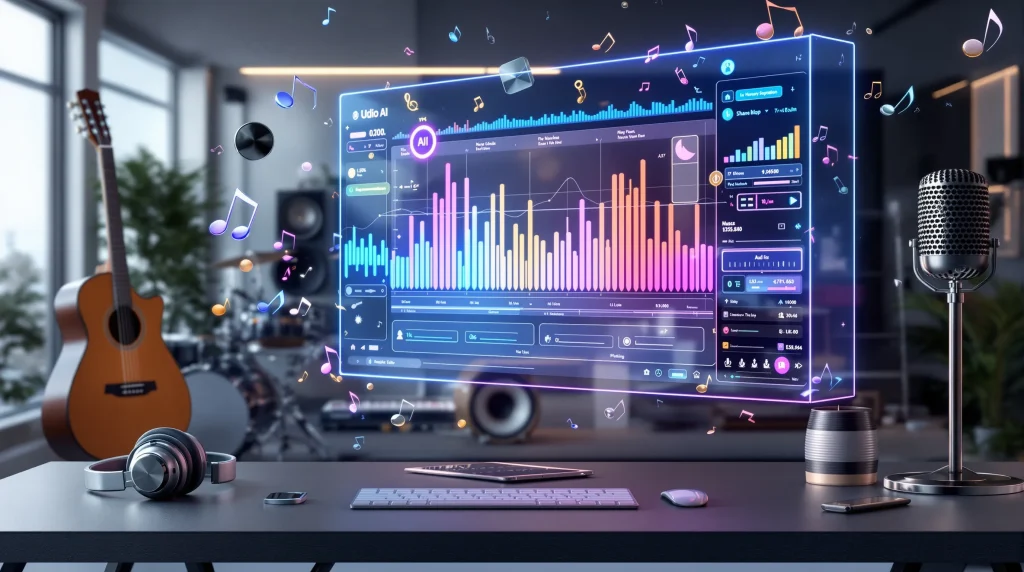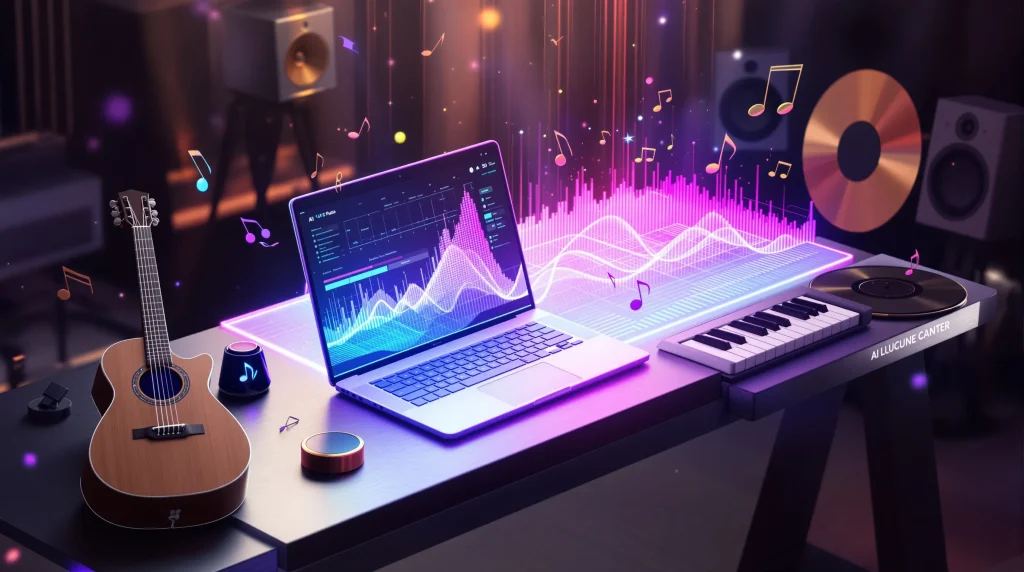我們正在見證音樂創作的革命,而且現在就正在發生。AI 驅動的工具正在改變我們對音樂作曲、製作與分享的思考方式,而且 Udio AI 正站在這個轉變的最前線。無論您是急於尋找原創背景音軌的內容創造者、需要為宣傳活動自訂音訊的行銷人員,或是純粹喜歡嘗試聲音的人,Udio AI 都能提供令人信服的解決方案,既容易使用,又令人驚訝地精巧。.
在這篇文章中,我們將介紹您需要瞭解的所有關於 Udio AI 音樂產生器的資訊:它是什麼、如何運作、它的突出功能、實際應用,以及它在競爭中的優勢。到最後,您就能清楚了解 Udio AI 是否值得列入您的創意工具包。.
什麼是 Udio AI 音樂產生器?
Udio AI 是人工智慧驅動的音樂產生器,可將文字提示轉換成完整的原創音樂曲目。Udio AI 於 2024 年推出,由一群前 Google DeepMind 研究人員所組成,他們看到了音樂製作民主化的機會。傳統的數位音訊工作站 (DAW) 需要專業技術、音樂理論知識以及數小時的實際操作,而 Udio AI 則不同,任何人都能在幾分鐘內創作出專業音效的作品。.
Udio AI 的核心是運用先進的機器學習模型,這些模型是根據不同類型、風格和時代的大量音樂資料集訓練而成。當您輸入文字描述時,例如「帶有合成器旋律的歡快電子舞曲」或「帶有女聲的憂鬱原聲民謠」,AI 會詮釋您的意圖,並將您的描述轉換成您想要的音樂。 產生獨特的音樂 符合您的規格。.
Udio 與其他簡單的 AI 音樂工具不同之處在於它不僅能產生樂器音軌,還能產生歌詞和人聲。這個平台可以製作有連貫性的歌曲,包含歌詞與副歌的結構、不同風格的人聲表演,以及可媲美人工製作音軌的製作品質。我們見過使用者在不碰觸樂器或開啟傳統音樂軟體的情況下,創造出從懶散的學習節奏到完整的流行歌曲。.
此平台完全在雲端透過網頁介面運作,任何裝置只要有網際網路連線即可存取。這種以瀏覽器為基礎的方式意味著在您開始創作之前,不需要下載軟體,不需要擔心系統需求,也不需要克服陡峭的學習曲線。.
Udio AI 的主要功能
文字轉音樂
Udio AI 功能的基礎在於其文字轉音樂的能力。您只需描述您想要的音樂種類,AI 就會幫您完成繁重的工作。提示系統非常靈活,您可以含糊其辞(“chill background music「),也可以非常具體(」90 年代 West Coast hip-hop with boom bap drums and jazzy piano samples”)。.
這項功能特別令人印象深刻的是 AI 如何詮釋細微的差異。如果您要求一首「哀傷的鋼琴曲」,它不僅能理解樂器,還能理解傳達哀傷的情感基調、節奏與和聲選擇。我們發現更詳細的提示通常會產生更好的結果,但即使是簡單的描述也能產生令人驚訝的好曲目。.
生成過程通常需要 30-60 秒,之後您會收到兩種變體供您選擇。這讓您有更多選擇,並增加找到符合您願景的機會。如果兩個版本都不符合要求,您可以使用相同的提示重新生成,或者調整您的描述再試一次。.
智慧歌詞與聲樂創作
Udio AI 的突出功能之一是能夠產生歌詞和演唱。您可以提供自己的歌詞,也可以讓 AI 根據您的提示來寫歌詞,或是介於兩者之間。AI 能以自然而非強迫的方式處理押韻、音節數和歌詞流程。.
人聲合成同樣令人印象深刻。Udio 可以產生各種風格的男聲或女聲,從流暢的 R&B 到粗獷的搖滾人聲,從說唱到歌劇表演。AI 甚至可以根據您所要求的風格來處理伴唱、和聲和副歌。.
我們注意到,聲音品質會因歌曲類型和要求的複雜性而有所不同,但在最佳狀態下,Udio 所製作的聲音讓許多聽眾不會馬上認出是 AI 產生的。一般來說,發音清晰、時間與節奏鎖定得很好,而情感的表達往往能令人信服地配合歌曲的意境。.
流派多樣性與風格控制
Udio AI 不會將您侷限於少數的一般風格。該平台可處理令人印象深刻的各種類型:電子、搖滾、流行、嘻哈、爵士、古典、鄉村、金屬、環境、世界音樂,以及無數的次類型和融合風格。.
除了廣泛的類型選擇外,您還可以指定風格元素,如樂器、節奏、情緒、時代和製作風格。想要聽起來像 80 年代合成器浪潮的曲目?沒問題。需要臥室製作人的低保真美學?沒問題。想要具有電影戲劇效果的管弦樂編曲?Udio 也能做到。.
這種多樣性延伸至平台對音樂製作常規的理解。如果您要求「Trap 節拍」,您會聽到「hi-hat rolls」、「808 bass」和「Trap 節奏模式」。如果要求「搖滾」,您會聽到混響吉他牆和空靈的人聲。AI 顯然不只瞭解哪些樂器屬於不同類型,也瞭解這些類型如何構造和產生其特有的聲音。.
如何使用 Udio AI 音樂產生器
建立您的第一條音軌
開始使用 Udio AI 非常簡單直接。註冊帳號後,您會立即進入創作介面。主要的元件是一個文字提示方塊,讓您描述想要創作的音樂。.
比方說,您需要烹飪影片的背景音樂。您可以輸入「歡快的原音民謠音樂,伴隨著四弦琴和輕快的敲擊樂,歡快而溫暖」。按下產生按鈕,等待一分鐘左右,Udio 就會為您呈現兩種 30 秒的曲目變化。.
您可以聆聽兩個版本,然後選擇更符合您願景的版本。如果您希望 AI 寫歌詞並加人聲,您可以在提示中指定(「有女聲演唱的關於夏天的獨立流行歌曲」)或切換歌詞選項。對於只有樂器演奏的曲目,只要不提及人聲或在提示中指定「樂器演奏」即可。.
介面會顯示您所產生的音軌波形,並提供播放控制。您可以以各種音訊格式下載您的創作,視您的訂閱等級而定,可提供更高品質的輸出。我們建議您先從較簡單的提示開始,學習 AI 如何詮釋不同的描述,然後再逐漸嘗試更詳細、更複雜的要求。.
自訂及延伸您的音樂
一旦您產生了喜歡的曲目,Udio AI 會提供幾種方式來精煉和擴充它。擴充」功能特別有用,它可以讓您將 30 秒的片段發展成一首完整的歌曲。AI 能維持音樂的連續性,創造自然的轉場,並發展最初的想法,而不是簡單的循環。.
您可以朝任何一個方向延伸您的樂曲:在現有的部分之前加入前奏,或在其後加入新的部分,或兩者兼而有之。這時您可能會加入橋段、吉他獨奏,或讓歌曲進入高潮。每種延伸都能保持原曲的風格和感覺,同時引入適當的變化。.
Udio 也允許您重新混音或創作現有曲目的變奏。如果您喜歡一首已生成歌曲的大部分元素,但想嘗試不同的演唱方式或調整配器,您可以使用變奏功能來創建替代曲目,這些曲目具有相同的核心基因,但探索的方向不同。.
為了加強控制,您可以編輯人聲音軌的歌詞,準確指定您希望 AI 唱出的內容。這對於需要傳達符合品牌指導方針的訊息的商業專案而言,或是當您在製作具有特定敘事內容的歌曲時,都是無價之寶。AI 會以您自訂的歌詞重新合成人聲,並維持音樂背景和整體風格。.
Udio AI 的實用案例
內容創作與社群媒體
Udio AI 為內容製作人解決了一個長期困難的問題:尋找真正適合您內容的原創、免版權音樂。YouTube 創作人、播客和 TikTok 製作人經常需要新鮮的音訊,而標準的免版權費音樂庫可能會讓人覺得很一般或被過度使用。.
有了 Udio,我們可以精準地為每個影片或專案製作自訂曲目。需要 90 秒的播客前奏主題嗎?只需數分鐘即可完成。需要符合您視訊文章特定情境的背景音樂?請準確描述您的需求並製作。這些音樂都是您的原創作品,可消除版權疑慮,並確保您的內容能以獨特的音訊脫穎而出。.
社交媒體經理也能從 Udio 的快速週轉中獲益。當您每天都要在多個平台上製作內容時,能夠按需產生合適的背景音軌,而無需搜尋音樂庫或洽談授權,是工作流程上的一大優勢。.
商業與專業應用
除了個人創作者之外,Udio AI 也可應用於商業與專業領域。行銷公司可以製作自訂的金曲和品牌歌曲,而無需僱用作曲家或進行昂貴的錄音室製作。小型企業可以製作反映其品牌形象的等候音樂、宣傳音訊或店內播放清單。.
我們看到遊戲開發人員在開發過程中使用 Udio 來製作背景音樂原型,在委託製作配樂之前為不同的遊戲環境製作氛圍音軌。電影和影片製作人在剪輯過程中使用 Udio 製作臨時音軌,有些獨立製作甚至在最終剪輯時使用 Udio 製作的音樂。.
儘管如此,值得注意的是,雖然 Udio 能創造令人印象深刻的成果,但該平台最適用於音樂支援而非定義體驗的專案。對於以音樂為核心的高風險商業工作、大型廣告活動、劇情電影或旗艦品牌計畫,人類作曲家仍能提供人工智能尚未完全複製的用心程度與藝術細節。但對於廣大的中階專業需求而言,Udio 能以傳統成本與時間投資的一小部分,提供綽綽有餘的品質。.
Udio AI 定價與可用性
Udio AI 採用免費模式運作,讓大多數使用者在投入資金之前,有探索平台的空間。免費層級包括有限的每月世代數,足以測試平台和偶爾創作曲目,但不足以大量或商業使用。.
對於需要更多容量的創作者,Udio 提供訂閱方案。標準方案通常每月約 $10,包括每月數百個世代、更高品質的音訊匯出,以及更快的世代時間。專業計畫的月費約為 $30,取消了大部分的世代限制,提供最高的音訊品質,並授予商業使用權,如果您是為客戶或付費平台製作內容,這是非常重要的考量。.
這些價格讓 Udio 在 AI 音樂領域中具有競爭力。當我們將其與股票音樂訂閱費用 (通常每月 $15-30 的有限下載) 或僱用音樂人和製作人的費用 (每首曲目數百到數千不等) 相較時,其價值主張就變得很清楚了,尤其是對於經常需要自訂音樂的使用者而言。.
瞭解您所屬等級的授權條款非常重要。免費和標準層級通常包含非商業個人專案的使用權,而商業應用程式、任何付費或客戶工作,通常需要訂閱專業版。我們建議您隨時查看 Udio 網站上的最新條款,因為定價和授權細節可能會改變。.
此平台可在全球透過任何現代網路瀏覽器存取,我們沒有遇到任何地理限制。這種全球可用性意味著各地的創作者都能使用同樣強大的工具,無論他們當地的音樂製作資源或基礎設施如何。.
Udio AI 與其他音樂產生器的比較
Udio AI 在人工智能音樂產生器的領域中日益擁擠,Suno AI、Soundful、AIVA 和 Boomy 等競爭對手都在爭奪創作人的注意力。那麼 Udio 在這個領域中的定位為何?
與 Udio 最接近的競爭對手 Suno AI 相比,這兩個平台所提供的功能非常相似,都擅長將文字轉換為帶人聲的音樂,而且涵蓋的類型範圍也不相上下。使用者通常會形容這場競爭是個人對於 AI「聲音」和詮釋風格的喜好問題。我們發現 Udio 在詮釋複雜提示的方式上略為直覺,不過 Suno 偶爾也會依類型做出更精緻的聲音表演。.
AIVA 採用不同的方式,更專注於電影配樂和古典音樂的器樂作曲。它提供更細緻的作曲控制,但缺乏 Udio 的人聲合成功能。對於需要歌詞歌曲的創作者而言,Udio 是當之無愧的贏家。對於需要細部控制的管弦樂作曲家而言,AIVA 可能會比較適合。.
Soundful 和 Boomy 針對循環和節拍製作領域,提供適合串流或環境使用的重複背景音軌。它們比 Udio 更簡單、更有限,但在某些使用情況下也更實惠、更快速。如果您需要有結構和人聲的完整歌曲,Udio 會比這些替代品優勝很多。.
Udio 對許多使用者來說的優勢在於它所取得的平衡:既有專業品質的輸出,又不會過於複雜;既有廣泛的類型涵蓋,又不會犧牲任何特定風格的深度;既有足夠的控制來引導 AI,又不需要技術性的音樂知識。它對初學者來說很容易上手,但功能強大,讓有經驗的音樂家也能發現它的創意價值。.
沒有任何 AI 音樂產生器是完美的,Udio 偶爾也會產生轉場奇怪、混音選擇有問題或歌詞不太貼切的曲目。但在我們跨平台的測試中,Udio 在整體品質、多功能性和易用性方面,一直名列前茅。.
總結
Udio AI 代表著無障礙音樂創作的一大躍進。我們已經超越了簡單的迴圈和一般的伴奏音軌,進入到 AI 可以產生完整、有結構的歌曲的時代,包括人聲、歌詞和製作品質,並能在專業的環境中站得住腳。.
對於內容創造者、行銷人員、小型企業及業餘愛好者而言,Udio 能解決真正的問題:它比僱用音樂家更快、比製作室更經濟實惠、比庫存音樂庫更可自訂、比循環再用的免版稅曲目更原創。Udio 的學習曲目極少,效果令人印象深刻,創意的可能性令人真正興奮。.
這並不表示 AI 會取代人類音樂家,熟練的作曲家所帶來的藝術性、意向性與情感深度仍然非常重要。但 Udio AI 和類似的工具正為過去不可行或無法負擔的客製音樂專案開闢寶貴的空間。.
如果您一直對 AI 音樂生成感到好奇,我們建議您試試 Udio。從免費的層級開始,嘗試不同的提示和風格,看看是否適合您的創作流程。您可能會對自己的創作感到驚訝,而且這項技術發展得如此迅速,讓每個人都能輕鬆進行音樂製作。.
常見問題
什麼是 Udio AI 音樂產生器,它如何運作?
Udio AI 是一款人工智慧驅動的音樂產生器,可將文字提示轉換為完整的原創音樂曲目。它使用在龐大音樂資料集上訓練的先進機器學習模型來詮釋您的描述,並在幾分鐘內生成帶有人聲、歌詞和專業製作品質的獨特作品。.
Udio AI 可以產生有人聲和歌詞的歌曲嗎?
是的,Udio AI 可以產生各種風格的歌詞和演唱。您可以提供自己的歌詞,讓 AI 來寫,或是合作完成。此平台可製作不同類型的男聲或女聲,包括和聲與伴唱,聽起來既自然又符合情感。.
Udio AI 用於商業用途的費用是多少?
Udio AI 提供世代有限的免費層級、每月約 $10 的標準方案,以及每月約 $30 的專業方案。商業使用權通常需要專業訂閱,包括無限世代和最高音訊品質的付費內容。.
Udio AI 是否比 Suno AI 更適合音樂生成?
Udio AI 和 Suno AI 的功能非常相似,品質也不相上下。選擇與否通常取決於個人對 AI 詮釋風格的偏好。Udio 傾向於以更直覺的方式處理複雜的提示,而 Suno 則依類型偶爾會產生更精緻的聲音。.
Udio AI 輸出音樂的檔案格式為何?
Udio AI 允許您下載以各種音訊格式產生的曲目,並可依訂閱等級提供更高品質的輸出。此平台完全透過網頁瀏覽器運作,無須安裝軟體即可從任何裝置存取。.
來自 Udio 的 AI 生成的音樂可以在 YouTube 上使用而不涉及版權問題嗎?
是的,使用 Udio AI 生成的音樂是原創的,無版權限制,可供您使用,消除了 YouTube 上的版權問題。但是,如果您的內容是用來賺錢的,您必須確保您的訂閱層級包含商業使用權,這通常需要專業計劃。.



